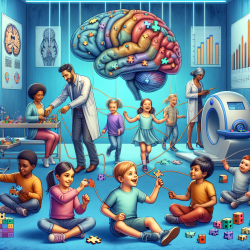Introduction
In the realm of speech-language pathology, understanding the neurodevelopmental processes that underpin cognitive functions is pivotal. A recent study, "Aperiodic EEG and 7T MRSI evidence for maturation of E/I balance supporting the development of working memory through adolescence," provides valuable insights into the maturation of working memory during adolescence. This blog explores the implications of this research for practitioners aiming to enhance their therapeutic approaches.
Understanding the Research
The study employs a combination of ultra-high field 7T Magnetic Resonance Spectroscopic Imaging (MRSI) and Electroencephalography (EEG) to investigate the maturation of the prefrontal cortex (PFC) through adolescence. This maturation is marked by changes in the excitation/inhibition (E/I) balance, which are crucial for the development of working memory.
Key findings from the research include:
- Developmental increases in the balance of excitatory glutamate and inhibitory GABA neurotransmitters.
- Changes in E/I balance assessed by the suppression of prefrontal aperiodic activity, which facilitate improvements in working memory.
- Evidence of physiological changes in the human association cortex consistent with critical period plasticity during adolescence.
Implications for Practice
For practitioners, these findings underscore the importance of targeting E/I balance in therapeutic interventions. Here are some actionable strategies:
- Incorporate Neurofeedback: Utilize EEG-based neurofeedback to help adolescents regulate their E/I balance, potentially enhancing working memory and cognitive control.
- Focus on Critical Periods: Tailor interventions to coincide with critical periods of neurodevelopment, maximizing the plasticity of the adolescent brain.
- Monitor Neurotransmitter Levels: Consider approaches that support the optimal balance of glutamate and GABA, such as dietary modifications or supplements, under medical guidance.
Encouraging Further Research
While this study provides foundational insights, further research is essential to explore the nuances of E/I balance and its impact on cognitive development. Practitioners are encouraged to engage in or support research efforts that delve deeper into these mechanisms.
Conclusion
The maturation of the PFC and the development of working memory during adolescence are complex processes influenced by the E/I balance. By integrating these insights into practice, speech-language pathologists can enhance their interventions and support better outcomes for children.
To read the original research paper, please follow this link: Aperiodic EEG and 7T MRSI evidence for maturation of E/I balance supporting the development of working memory through adolescence.










